NDVI stands for "Normalized Difference Vegetation Index". NRG stands for "Near-infrared / Red / Green". NDVI and NRG are both ways to visualize the amounts of infrared and other wavelengths of light reflected from vegetation. Because both these methods compare ratios of blue and red light absorbed versus green and IR light reflected, they can be used to evaluate the health of vegetation. It's a snapshot of how much photosynthesis is happening. This is helpful in assessing vegetative health or stress. (Read more here: https://www.agronomy.org/publications/jeq/articles/36/3/832) ## Do-It-Yourself These techniques for vegetation analysis were developed for satellite imagery, but at Public Lab, we've been working a lot on capturing infrared imagery using our DIY [near-infrared camera](/wiki/near-infrared-camera) setup, and combining it with visible bands to produce NDVI images such as the one above. ## What these images mean What exactly are these images we're trying to make? What do they tell us about vegetation, and why? These diagrams should help to understand what it is we're doing and why these are good ways to analyze plant life. ## The NDVI equation [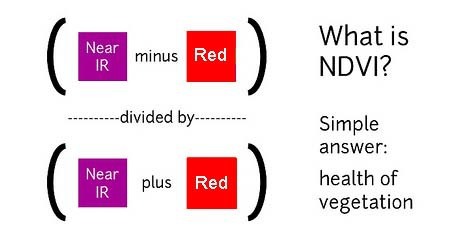](/i/44723) **NDVI = (Near Infrared - Red)/(Near Infrared + Red)** NDVI is a ratio which tries to emphasize photosynthesis while filtering out sun glare. The above equation is run for every pixel, using source data from an infrared photo and a visible light photo, like this pair: [](https://publiclab.org/system/images/photos/000/021/771/original/5390895115_c9d4d38fec_o.jpg) The result can be false-colored to make the high-photosynthesis areas more clear, and used to examine where plants are and how healthy they are. [](https://publiclab.org/system/images/photos/000/021/770/original/PetVISNDVIcomp.png) _Figure above: Normal color photo (right) and normalized difference vegetation index (NDVI) image (left). NDVI image was derived from two color channels in a single photo taken with a camera modified with a special infrared filter. Note that tree trunks, brown grass, and rocks have very low NDVI values because they are not photosynthetic. Healthy plants typically have NDVI values between 0.1 and 0.9. -- @cfastie_ ### Activities Here are a range of activities you can do to produce and interpret your own NDVI imagery, whether downloaded from a satellite imagery provider or [collected yourself using a DIY technique](/wiki/multispectral-imaging) [activities:ndvi] ****   Most DIY converted cameras today (those from Public Lab) use RGN instead of NRG, so the blue channel represents infrared instead of the red channel. That looks like this: [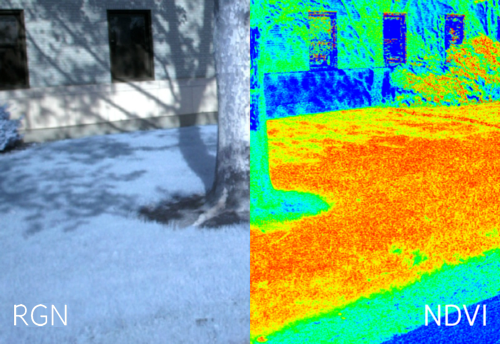](/i/45468?s=o) **** ## NRG imagery Some people are also interested in producing NRG imagery (like the below image), where `Near-Infrared, Red, and Green` are used to compose a picture instead of the usual `Red, Green, and Blue`. [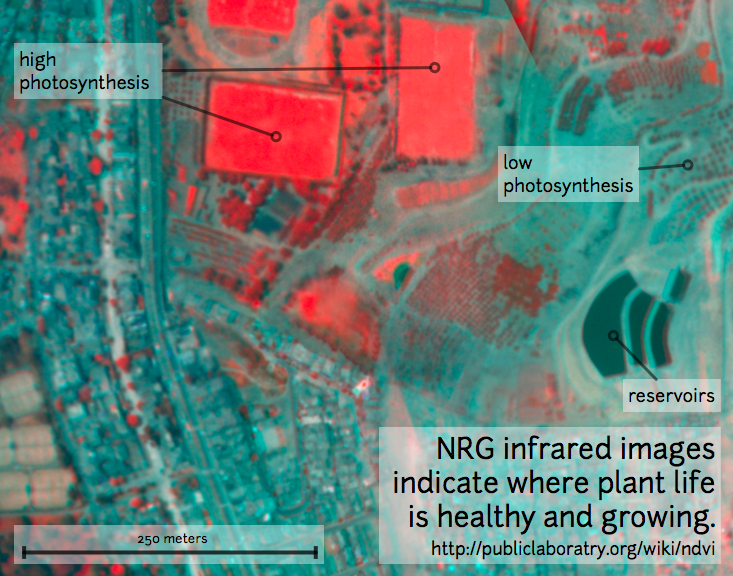](/i/25064) This diagram explains the swapping, which allows us to 'see' infrared as if it were a normal color: [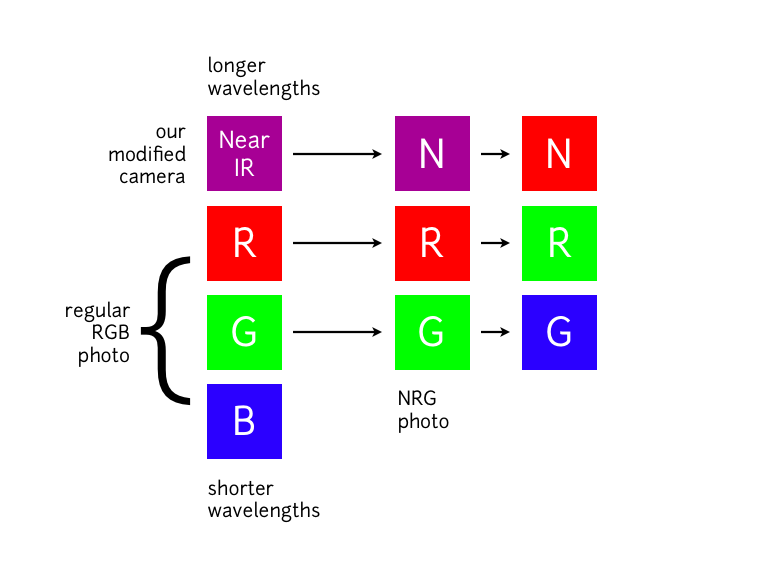](/i/25063) **In NRG images, the deeper and clearer the red color, the denser and healthier the vegetation (more or less).** ### Questions [questions:ndvi] ### Other examples of DIY NDVI imaging From around the internet: Begin watching at 2 minutes to see the resulting imagery: *This topic is part of the [Grassroots Mapping Curriculum](/wiki/mapping-curriculum) series.* **** [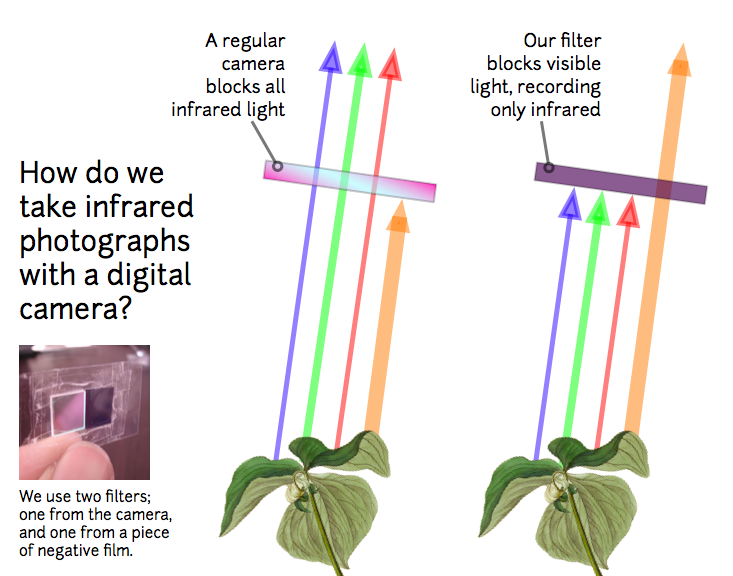](/i/25066) [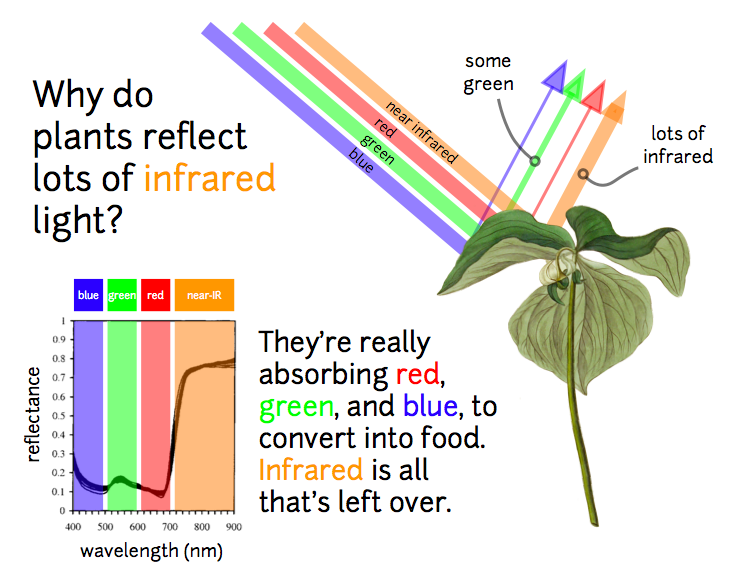](/i/25065) ...
| Author | Comment | Last activity | Moderation | ||
|---|---|---|---|---|---|
| warren | "OH, i see - you have NDVI running, but want to do NRG. Well, NRG is typically showing red and green in the green and blue channels, and in the curr..." | Read more » | over 10 years ago | |||
| warren | "Hi, very cool! Would you be willing to open source your patch by sharing it in this note? I love Max/MSP and also Pure Data/PD! If it's easier, th..." | Read more » | over 10 years ago | |||
| nedhorning | "I often use platforms that are moving so I use a fast shutter speed to reduce blur. I often shoot somewhere around 1/1000th of a second. You should..." | Read more » | over 10 years ago | |||
| nedhorning | "I usually use a gray target to white balance my NIR camera but I know some people use green vegetation like grass for the white balance. You can ex..." | Read more » | over 10 years ago | |||
| gpenzo | "ttaylor you make some good points there. My cameras are not on a gimbal but directly connected to the drone (pure for kiss). Because of some gust t..." | Read more » | over 10 years ago | |||
| ttaylor | "Interesting work indeed. I have a few partly formed thoughts: 1) since there is a thunderstorm, the illumination conditions are highly variable an..." | Read more » | over 10 years ago | |||
| gpenzo | "Good point Ned. I'm going to lock everything in those cam. Event the photos are not good I love the sharpness. Ned should I use white background fo..." | Read more » | over 10 years ago | |||
| warren | "Ned, those are some great points -- would you mind if I used them as the basis of a new page at: http://publiclab.org/wiki/infragram-analysis ? " | Read more » | over 10 years ago | |||
| nedhorning | "The NIR and visible images look a little different and that could be caused by a few factors. If any of the camera settings change between images i..." | Read more » | over 10 years ago | |||
| GreenLeaves | "Hi warren, on this photo we didn't use white balance, it was one of our first photos after we exchanged the IR filter by the blue one. The camera i..." | Read more » | over 10 years ago | |||
| warren | "Hi, GreenLeaves - this one's white balance is not as good as http://publiclab.org/notes/GreenLeaves/07-04-2014/images-with-our-new-selfbuilt-camera..." | Read more » | over 10 years ago | |||
| nedhorning | "When I created the images above I scaled the output so and NDVI or DVI values less than 0 were set to 0. To include the full range of possible valu..." | Read more » | over 10 years ago | |||
| sabinozootec | "The images created on ImageJ/Fiji generate values from -1 to 1, although being in the range from 0 to 1. Creating images as figures 0-1? " | Read more » | over 10 years ago | |||
| Henry0815 | "Excellent! Ideal or sensor observation in a stand off fashion if installed on a UGV or dangling from a kite or pole. " | Read more » | over 10 years ago | |||
| Philgib | "Excellent ! " | Read more » | over 10 years ago | |||
| Dongjie | "cool! " | Read more » | over 10 years ago | |||
| warren | "I believe the WebRTC video api can use a remote stream as a video source instead of Infragram.org's use of a local webcam. I bet it could be set up..." | Read more » | over 10 years ago | |||
| mathew | "this is really cool, and moving towards an autonomous trap camera! I'm really glad to see you working on the GSM modem. " | Read more » | over 10 years ago | |||
| danbeavers | "Great writeup! " | Read more » | over 10 years ago | |||
| warren | "Awesome, great work Ned! " | Read more » | over 10 years ago | |||
| nedhorning | "Chris - I want to test to see how well calibration transfers between cameras and also between different camera settings and incident light (clear v..." | Read more » | over 10 years ago | |||
| cfastie | "Those regressions look really encouraging. I guess if I took some photos with my own A2200 and Wratten 25A filter (the same model and filter type y..." | Read more » | over 10 years ago | |||
| patcoyle | "Thanks for all the work you are doing to improve this approach. " | Read more » | over 10 years ago | |||
| patcoyle | "Thanks for all the work you've done on this amazing tool. Nice enhancements, put in context. " | Read more » | over 10 years ago |